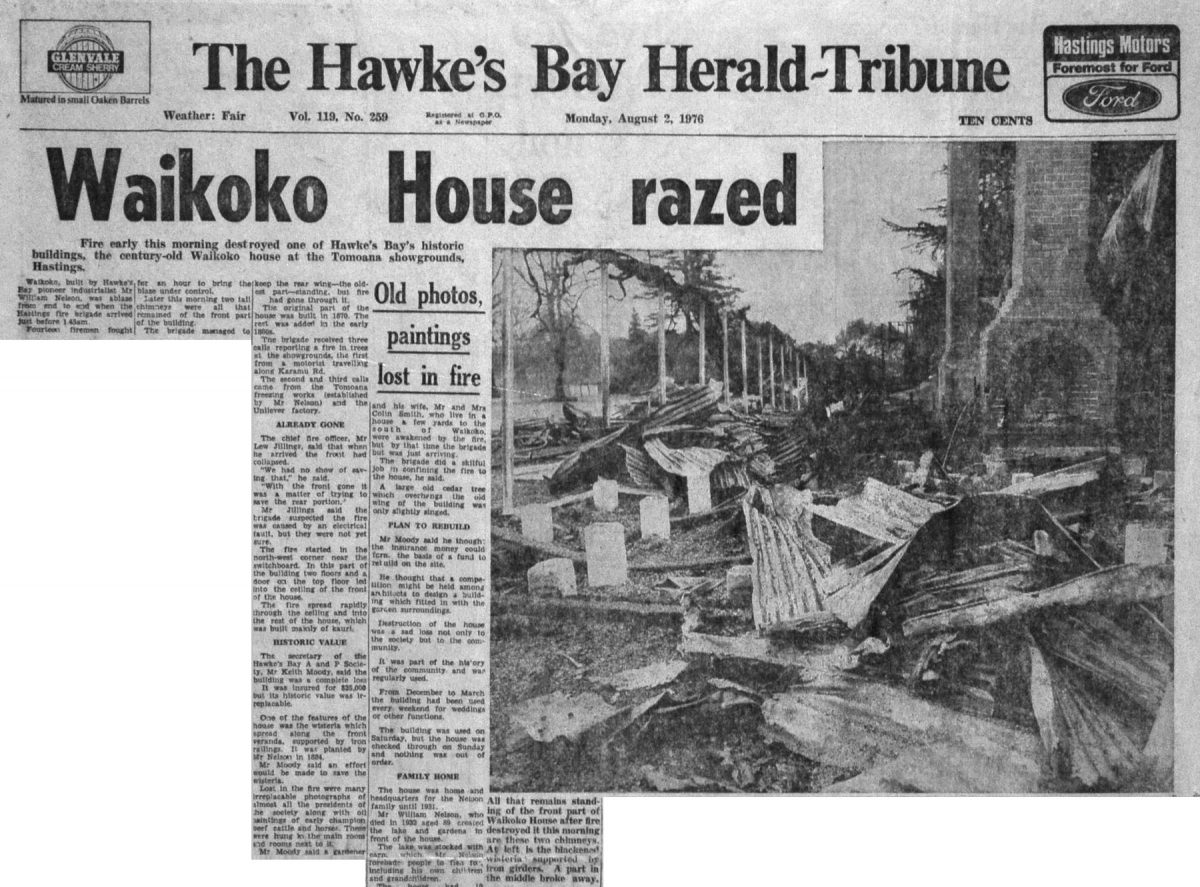The Hawke’s Bay Herald-Tribune
Vol. 119, No 259 Monday, August 2, 1976
Waikoko House razed
Old photos, paintings, lost in fire
Fire early this morning destroyed one of Hawke’s Bay’s historic buildings, the century-old Waikoko house at the Tomoana showgrounds, Hastings.
Waikoko, built by Hawke’s Bay pioneer industrialist Mr William Nelson, was ablaze from end to end when the Hastings fire brigade arrived just before 1.45am.
Fourteen firemen fought for an hour to bring the blaze under control.
Later this morning two tall chimneys were all that remained of the front part of the building.
The brigade managed to keep the rear wing – the oldest part – standing, but fire had gone through it.
The original part of the house was built in 1870. The rest was added in the early 1880s.
The brigade received three calls reporting a fire in trees at the showgrounds, the first from a motorist travelling along Karamu Rd.
The second and third calls came from the Tomoana freezing works (established by Mr Nelson) and the Unilever factory.
ALREADY GONE
The chief fire officer, Mr Lew [Lou] Jillings, said that when he arrived the front had collapsed.
“We had no show of saving that,” he said.
“With the front gone it was a matter of trying to save the rear portion.”
Mr Jillings said the brigade suspected the fire was caused by an electrical fault, but they were not yet sure.
The fire started in the north-west corner near the switchboard. In this part of the building two floors and a door on the top floor led into the ceiling of the front of the house.
The fire spread rapidly through the ceiling and into the rest of the house, which was built mainly of kauri.
HISTORIC VALUE
The secretary of the Hawke’s Bay A and P Society, Mr Keith Moody, said the building was a complete loss.
It was insured for $25,000 but its historic value was irreplaceable.
One of the features of the house was the wisteria which spread along the front veranda, supported by iron railings. It was planted by Mr Nelson in 1884.
Mr Moody said an effort would be made to save the wisteria.
Lost in the fire were many irreplaceable photographs of almost all the presidents of the society along with oil paintings of early champion beef cattle and horses. These were hung in the main room and rooms next to it.
Mr Moody said a gardener and his wife, Mr and Mrs Colin Smith, who live in a house a few yards to the south of Waikoko, were awakened by the fire, but by that time the brigade was just arriving.
The brigade did a skilful job in confining the fire to the house, he said.
A large old cedar tree which overhangs the old wing of the building was only slightly singed.
PLAN TO REBUILD
Mr Moody said he thought the insurance money could form the basis of a fund to rebuild on the site.
He thought that a competition might be held among architects to design a building which fitted in with the garden surroundings.
Destruction of the house was a sad loss not only to the Society but to the community.
It was part of the history of the community and was regularly used.
From December to March the building had been used every weekend for weddings or other functions.
The building was used on Saturday, but the house was checked through on Sunday and nothing was out of order.
FAMILY HOME
The house was home and headquarters for the Nelson family until 1931.
Mr William Nelson, who died in 1932 aged 89, created the lake and gardens in front of the house.
The lake was stocked with carp, which Mr Nelson forbade people to fish for, including his own children and grandchildren.
The house had 10 bedrooms, not including staff quarters, and was furnished in Victorian style.
Verandas ran round three sides of the house.
In 1931 Mr Nelson sold the house and the accompanying gardens and land of just over 41 acres for £11,000.
Since then the society has looked after the house, used it for its general committee meetings and hired it out.
Photo caption –
All that remains standing of the front part of Waikoko House after fire destroyed it this morning are these two chimneys. At left is the blackened wisteria supported by iron girders. A part in the middle broke away.












Do you know something about this record?
Please note we cannot verify the accuracy of any information posted by the community.